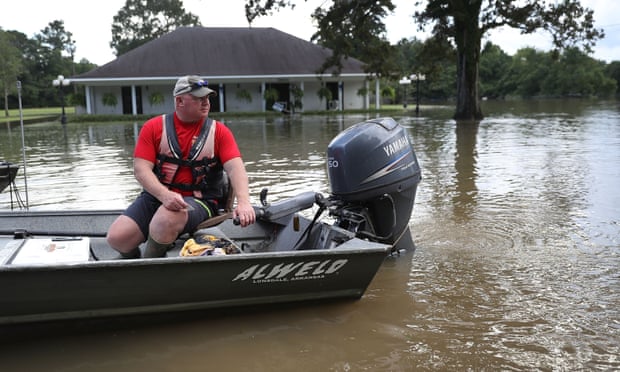An enormous and slow-moving rainstorm has laid waste to much of southernLouisiana, which the National Weather Service has called a “1,000-year” disaster.
By Monday afternoon, more than 20,000 residents had been rescued from the historic floodwaters, and as many as seven had died.
People here stay prepared for hurricanes, and all the cataclysm they bring. But this storm did not arrive with noise and velocity; instead it unfolded over several days, sneaking up almost without notice. Then the rivers topped their banks.more photos after the cut...
In Tangipahoa parish, Louisiana, Donnie Prince woke up Thursday morning to the sound of police on a bullhorn.“Evacuate immediately,” the voice said from outside his home.
It was 7am and there had been no water on the ground an hour earlier when Prince’s father-in-law, Raymond Fitzmorris, had woken up. Now Prince looked outside and saw 2ft of water everywhere, and rising fast.
Prince, 33, sat on a chair on Monday afternoon at a Red Cross shelter in Hammond, stunned by the scope of the flooding. In some communities – Denham Springs, for instance – 90% of houses flooded, leaving their owners homeless.
“We didn’t even have time to grab anything,” Prince said. He, his wife and his father-in-law scrambled to gather up the couple’s five children, aged three to 12, and make an escape to passing National Guard vehicles. They now have nothing.
Prince and 500 other rescued people landed at the Red Cross center in Hammond, one of dozens across the region that sprang up in response to the high water.
On Monday afternoon at the shelter, housed in a gym, those people sat or lay on cots and stared into rafters overhead. They traded juice boxes and survival stories.
One man had just had surgery, and needed a nurse.
A woman had given birth to her baby three days before.
Another man and his family had climbed into the attic of a two-storey home to escape the floodwaters, and could hear a helicopter circling overhead but could not signal it. So he dove into the water and swam down through their floating belongings, out a door and up to the surface, where the helicopter spotted him.
Marshall Ray Hayes, 69, lives in an apartment complex and was safe from the water until Thursday afternoon – “it just kept coming,” he said.
His distress was acute; he uses a wheelchair, and needed it to make an escape from his home, rolling out through the flood.
Monday he reached down and patted the wheel of the chair like the flank of a horse. “I wouldn’t have made it out without my chair,” he said.
The storm was born in the corner of Florida’s gulf coast in the first week of August, when the National Hurricane Center warned it could swerve into the gulf and pick up the tell-tale spin and speed of a tropical cyclone. Instead it poked westward along the gulf coast, finally settling over southern Louisiana, where it shed up to 3in of rain an hour.
The scale of the flooding was beyond the reach of any government agency, though. So from the bayous and swamps emerged something locals are calling the “Cajun navy”. Thousands of hunters and fishermen from throughout the region arrived in boats and organized themselves into search-and-rescue parties.
Brittany Cuccia, a college student from Thibodeaux, joined one 10-boat fleet Monday as it moved from house to underwater house. “I’d say we’ve pulled out 50 people at least,” she said.
Residents who needed help were stuck in homes with no power, she said. They had no way to call for help, and so they retreated higher and higher into their homes, praying for rescue.
Businesses, too, were destroyed. Liz Bemtivegna, of Tickfaw, said her antiques-restoration shop was wiped out. “But we will salvage what we can when the water goes down,” she said.





No comments:
Post a Comment